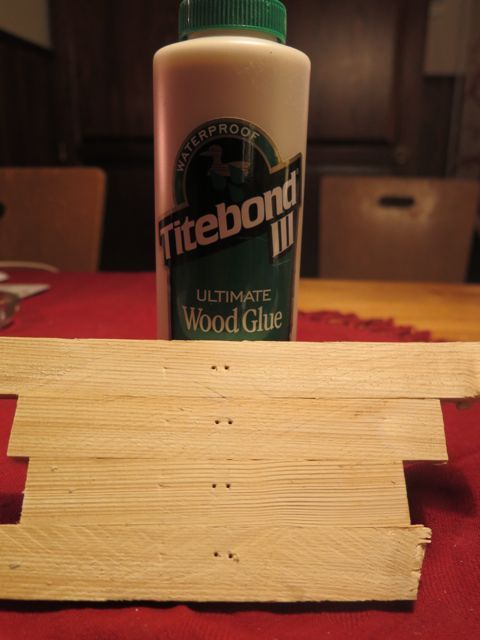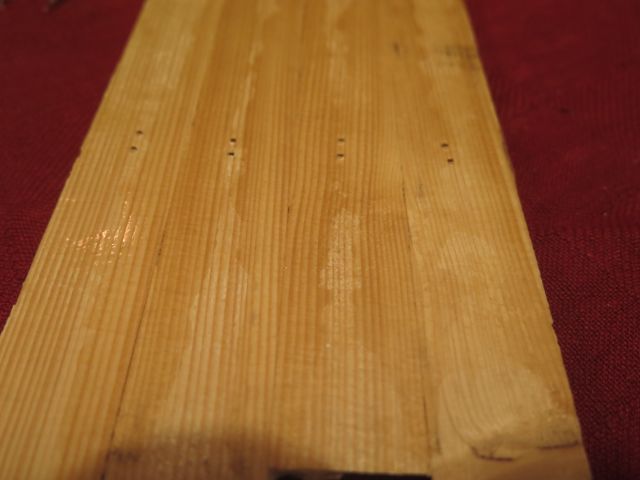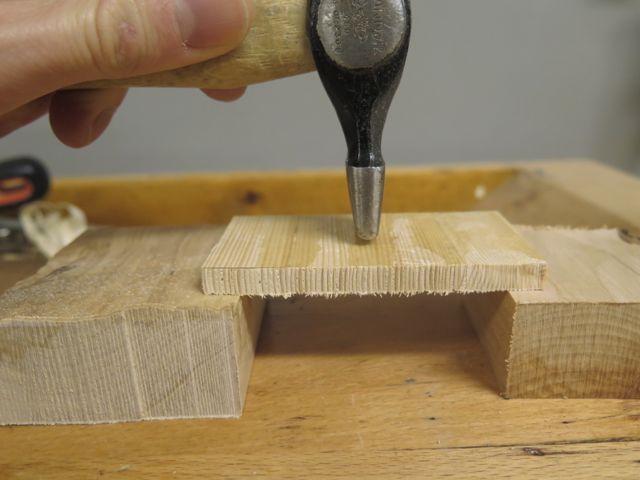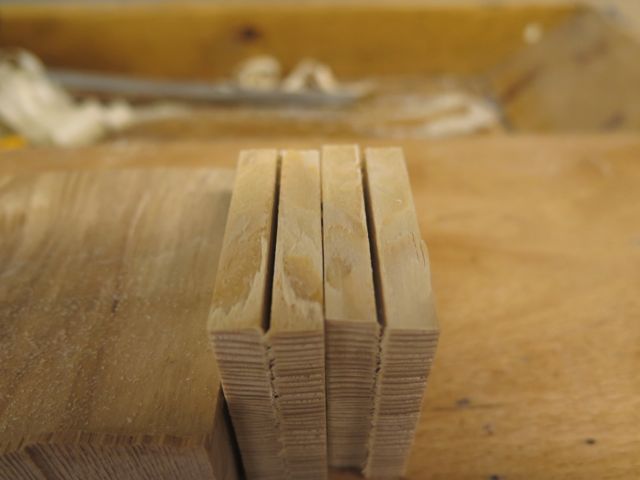Page 1 of 4
Bluefin SS&G
Posted: Fri Jan 03, 2014 2:10 pm
by trango
Dear all,
I'm new to this forum! My name is Fredrik and I'm living in the northern part of Sweden, close to the polar circle. I've just ordered the plans for a Bluefin and while waiting for them to arrive, I've started to prepare for the build. The kayak will be used for fishing in Norwegian fjords and one of the primary goals with the build is to keep the weight as low as reasonable. For that reason, and because good quality plywood is difficult to find, I've decided to try the SS&G technique. Yesterday I ripped approx. 60 strips with a length of 4,8 m (16 ft) down to 22*9 mm. They where subsequently planed down to 7 mm (little-bit more then 1/4 inch).
Today I've glued my first test panel using Titebond III. For my previous boats, I've always used epoxy, so this glue is a new experience for me and I'm very interested to try it out. From the specifications it looks very promising, the only concern is the recommended clamping pressure which certainly is higher then what I can reach when gluing the panels. To test the performance at lower clamping pressures, I simply glued a couple of strips, just by pressing them together and keep them fixed with a couple of staples.

The wood is "gran" or "Norwegian spruce" (Picea abies). Very light, very strong, very many knots... Glues very well and well suited for strip building if you plan to paint the hull. And as you can imagine, at our latitude all wood are slowly grown.
The planed surface went to the backside where excess glue is pressed out...

Is there any reason to worry about the ability of epoxy to bond to the glued surface? I imagine that I have to sand the surface before sheathing it?
Tomorrow, I will break this panel to get a feeling for the strength of the glue under these conditions.
/Fredrik
Re: Bluefin SS&G
Posted: Sat Jan 04, 2014 4:38 am
by trango
After curing the panel for 24 h, I re-sawed the panel to two pieces of equal size. These were subjected to a very primitive test that, although it bear little resemble with the stress that actually occur in a kayak, still give an idea about the strength of a joint;

The hammer was slowly pushed until the joint broke and the joints could be studied;

Maybe difficult to see, but the joint, even under less then ideal gluing conditions, seems to hold up well. The panel broke at the actual joint but also in the wood, indicating that the joint is almost as strong as the wood.
Although an epoxy joint is stronger at this low clamping pressure and less then ideal surface preparation, I'm surprised and satisfied with the performance of the glue.
/F
Re: Bluefin SS&G
Posted: Sat Jan 04, 2014 12:23 pm
by makenmend
Fredrik, I have made several boats this way, and yes they do stand up to wear and tear over time. When gassed inside and out they are extremely tough. Tip..no matter how meticulous you are gluing the panels up on the bench, it's virtually impossible to get them perfectly flat, so I cut my strips slightly thicker than required then run them through the planer when glue up is done, saves a lot of sanding.
I've also glassed the inside of my panels before assembling them, far easier on the bench, with no problems in assembly.
[URL=http://s469.photobucket.com/user/m ... .jpg[/img][/url]
[URL=http://s469.photobucket.com/user/m ... .jpg[/img][/url]
Re: Bluefin SS&G
Posted: Sat Jan 04, 2014 1:21 pm
by trango
makenmend wrote:Fredrik, I have made several boats this way, and yes they do stand up to wear and tear over time. When gassed inside and out they are extremely tough. Tip..no matter how meticulous you are gluing the panels up on the bench, it's virtually impossible to get them perfectly flat, so I cut my strips slightly thicker than required then run them through the planer when glue up is done, saves a lot of sanding.
I've also glassed the inside of my panels before assembling them, far easier on the bench, with no problems in assembly.
That's great! Thank you for explaining the procedure and saving me some time!
My plan was to edge-glue with titebond, sand excess glue from the face of the panel, sheath the backside of panel with glass and then run it a pass through the sander to get to the final dimensions. I guess that is more or less exactly as you have done...
/Fredrik
Re: Bluefin SS&G
Posted: Sun Jan 05, 2014 11:10 am
by makenmend
not exactly.
After edge gluing, I run both sides through planer, no sanding. Planer will give you a nice finish plus all panels will be the same thickness ( remember I started with slightly thicker panels/strips for this reason) then glass the insides.
MM
Panel cut to shape and planed ready for glass, inside only
[URL=http://s469.photobucket.com/user/m ... .jpg[/img][/url]
[URL=http://s469.photobucket.com/user/m ... .jpg[/img][/url]
[URL=http://s469.photobucket.com/user/m ... .jpg[/img][/url]
Re: Bluefin SS&G
Posted: Sun Jan 05, 2014 9:06 pm
by jem
very clean work.
Re: Bluefin SS&G
Posted: Mon Jan 06, 2014 2:49 am
by trango
Very nice work - handy planer you've got! How wide is it?
I really like the look of straint grain, knot free WRC! WRC is imported in Sweden, but rather expensive so I'll go with local woods for this build.
I think I'll glass one of the sides before planing. Despite the favourable test of the glue, I'm worried about the stability of the panels. I'm not convinced they can stand too much handling and to be fed trough the planer. I figure that with one side glassed, they will be very stable.
/Fredrik
Re: Bluefin SS&G
Posted: Mon Jan 06, 2014 10:35 am
by makenmend
[quote="trango"
I think I'll glass one of the sides before planing. Despite the favourable test of the glue, I'm worried about the stability of the panels. I'm not convinced they can stand too much handling and to be fed trough the planer. I figure that with one side glassed, they will be very stable.
/Fredrik[/quote]
OK, that's fine,but when you get your 1st panel glued up, you'll see what I refer to regarding nice flat panels. On my 1st time, I laboriously sanded to remedy these small imperfections.If you do not sand out these high/low area's and try to apply glass it could result in area's with voids.
So if you sand the back before glassing you'll be good,Having now done many panels I have no worries about the panel breaking up whilst planing. Your method will work fine I'm just lazy and take the east route

MM
Re: Bluefin SS&G
Posted: Mon Jan 06, 2014 10:38 am
by makenmend
Fredrik
Forgot to mention my planer max width is 13 inches.
Just reread your initial post, spruce will be great for a kayak, probably better than western red cedar, I wanted Spruce for the mast's on my last build but nor readily available to me and to expensive to ship, also I have used Titebond II on my kayaks with good results, used Titebond III on the sailboat due to heavier stress. These are both great for our applications.
Also you mentioned thickness sander, I guess it would achieve the same results as a planer, ??
MM
Re: Bluefin SS&G
Posted: Mon Jan 06, 2014 1:31 pm
by trango
makenmend wrote:Fredrik
Forgot to mention my planer max width is 13 inches.
Just reread your initial post, spruce will be great for a kayak, probably better than western red cedar, I wanted Spruce for the mast's on my last build but nor readily available to me and to expensive to ship, also I have used Titebond II on my kayaks with good results, used Titebond III on the sailboat due to heavier stress. These are both great for our applications.
Also you mentioned thickness sander, I guess it would achieve the same results as a planer, ??
MM
Again - very good to hear about your experience! When I mentioned a sander, I meant an ordinary ROS. The strips have been planed on one side and the idea is to put that side downwards when gluing up the panel. The reason why I want to sand is simply to remove excess glue that have been squeezed out from the joint!
To bad the freight is too expensive, otherwise I would gladly send some quality spruce to you! Here we can buy 2*4 inch for about $2/yard. By local builders considered superior to sitka spruce. But unfortunately, lots of knots so for a mast you really need to scarf the material.
A couple of years ago I started to build a boat using our local spruce, using plans intended for WRC construction. I had to steam very many of the strips to get them to conform to the shape. I doubt that had been necessary with WRC...
/Fredrik





